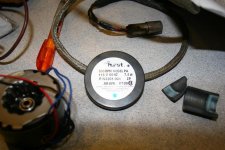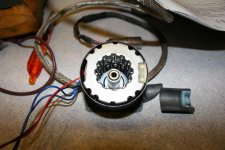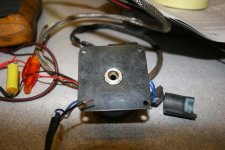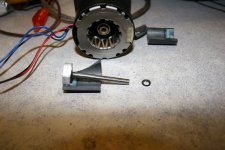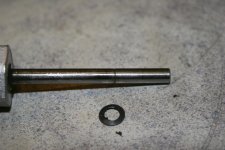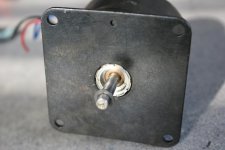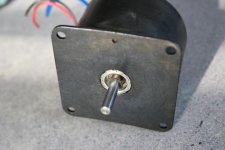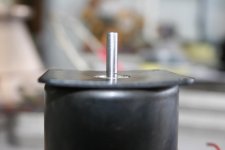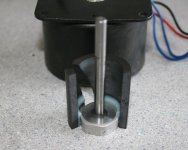Guys,
The point about "ball bearings" is that the bushings in the stock Hurst motors tend to be press fit, meaning very difficult to remove or to replace at least in the PA/PB series which are the most commonly used in audio, at least if we can use VPI turntables as a reference.
But, some of their motors have optional bearing configurations like bushings or bearings, and bushings and bearings on both ends of the shaft. These motors might have threaded assemblies or other assemblies that can be disassembled and replaced with better bushings, or replace the bearings with bushings.
Most of our familiarity with these motors is with the smallest in the range since commercial TT's tend to have light platters. These small motors are all press fit together. The large motors with die cast housings etc. tend to be screwed or bolted together. Again, more hot rod potential. (Yes, I know about the more torque more noise theories, but a heavy platter needs more torque).
I won't know for sure until I buy some of the other motors. There are at least 3 different motor families offered by Hurst in the 115V 300 rpm range. The RA and T series.
Capisce?
The point about "ball bearings" is that the bushings in the stock Hurst motors tend to be press fit, meaning very difficult to remove or to replace at least in the PA/PB series which are the most commonly used in audio, at least if we can use VPI turntables as a reference.
But, some of their motors have optional bearing configurations like bushings or bearings, and bushings and bearings on both ends of the shaft. These motors might have threaded assemblies or other assemblies that can be disassembled and replaced with better bushings, or replace the bearings with bushings.
Most of our familiarity with these motors is with the smallest in the range since commercial TT's tend to have light platters. These small motors are all press fit together. The large motors with die cast housings etc. tend to be screwed or bolted together. Again, more hot rod potential. (Yes, I know about the more torque more noise theories, but a heavy platter needs more torque).
I won't know for sure until I buy some of the other motors. There are at least 3 different motor families offered by Hurst in the 115V 300 rpm range. The RA and T series.
Capisce?
Here are the pictures of the original Hurst motor Autopsy from the other thread. I took this motor apart to try to identify the audible noise coming out of the motor from the shaft to bushing interface (not through the cartridge pickup).
One of the difficulties of working with this motor is that the top retaining washer, or thrust washer, it hard to access since it tends to sit down in the pocket of the bushing retaining sleeve. We removed the shaft and washer by driving the shaft out with a hammer which broke apart the magnet on the shaft.
One of the difficulties of working with this motor is that the top retaining washer, or thrust washer, it hard to access since it tends to sit down in the pocket of the bushing retaining sleeve. We removed the shaft and washer by driving the shaft out with a hammer which broke apart the magnet on the shaft.
Attachments
To get a better look at the longitudinal play of the shaft as retained by the two thrust washers on either side of the single bronze bushing I turned down the bearing retaining sleeve to get a better look at the top of the bushing in relationship to the retaining washer. I installed the motor shaft and pushed it till the thrust washer made contact on the bottom of the bearing sleeve. You can see there is a significant amount of play allowed between the top of the bushing and the top washer groove where the top retaining washer sits. I believe this causes the audible chatter.
I could only speculate that possibly the motor rotor is supposed to find it's "home" in the magnet field of the armature and that this play is by design. Or, I don't know.
With this particular motor it would be difficult to eliminate this play since everything is press fit together.
But, if someone wanted to disassemble this motor they should First remove the motor cap which is fairly easy to pry off. Then push the shaft up into the bushing. This might expose the top retaining washer such that it could be pried out of it's groove then the shaft is easily pulled out of the bushing.
I could only speculate that possibly the motor rotor is supposed to find it's "home" in the magnet field of the armature and that this play is by design. Or, I don't know.
With this particular motor it would be difficult to eliminate this play since everything is press fit together.
But, if someone wanted to disassemble this motor they should First remove the motor cap which is fairly easy to pry off. Then push the shaft up into the bushing. This might expose the top retaining washer such that it could be pried out of it's groove then the shaft is easily pulled out of the bushing.
Attachments
Regarding lubrication of this particular motor. I believe this motor should be easy to lubricate with whatever lubricant you like. For example oil, grease, whatever. There is significant clearance in the bushing and "pushing" grease or oil down into the bushing from the top should not hurt the motor. Notice that the shaft and magnet assembly tends to form a "cup" that would catch excess oil or grease or whatever. A thicker oil or grease might eliminate the audible chatter found in these motors and therefore almost all VPI TT's. Lube at your own risk but IMHO this motor would like some heavier weight lube.
Attachments
So oiling the motor would be fairly easy but make DIY mods would probably not be doable. Too bad.
Maybe somebody else can comment on the pictures.
Anyway, I called Maxton and they pointed out to a specific DC motor they say is very suitable for TT
A-max 26 Ø26 mm, Precious Metal Brushes CLL, 7 Watt, with terminal
And relative controller
ESCON 50/5, 4-Q Servocontroller for DC/EC motors, 5/15 A, 10 - 50 VD
They also asked for what speed and torque was exactly needed.
I sincerely have no clue as to what speed. These motors have a huge RPM Can I still use the pulley? Do I need Gearhead? (wouldn't a gearhead then introduce noise?) How does a DC system work?
I have no idea, if somebody can shed some light I would really appreciate it.
Also, would a motor with a controller like that be better than the Hurst with the dual phase controller?
Maybe somebody else can comment on the pictures.
Anyway, I called Maxton and they pointed out to a specific DC motor they say is very suitable for TT
A-max 26 Ø26 mm, Precious Metal Brushes CLL, 7 Watt, with terminal
And relative controller
ESCON 50/5, 4-Q Servocontroller for DC/EC motors, 5/15 A, 10 - 50 VD
They also asked for what speed and torque was exactly needed.
I sincerely have no clue as to what speed. These motors have a huge RPM Can I still use the pulley? Do I need Gearhead? (wouldn't a gearhead then introduce noise?) How does a DC system work?
I have no idea, if somebody can shed some light I would really appreciate it.
Also, would a motor with a controller like that be better than the Hurst with the dual phase controller?
the internals of that Hurst are nasty, no wonder there is loads of noise as it has one central shaft to fill with muck also higher contact area.
as for a DC motor you want it to spin at the same speed that yours spins at. torque.. yes as much as possible please. no you don't want a gear head. yes use your original pulley as long as the shaft size is the same if not go to your local machine shop with the motor and pulley and as them to make the pulley an interference fit to the motor spindle.
by design a good DC will outperform ANY AC motor for noise. DC motors got a bad reputation in the 80's when the drive systems were still in their infancy. they were plagued with speed drift and changes in ambient temperature. move on 30 years and DC motors and drive systems are far superior to AC. you still get your die hard AC fans that will defend AC motors till the end of time just like LINN LP12 owners defending an ancient TT design that LINN actually stole in the first place.
Stefanoo, i'm not being funny when i say give Arthur a call at Funk Firm and enquire about the K-Drive. he is a very very knowledgeable man with a huge reputation. who do you think brought us acrylic platters? Arthur did. who advocated the use of DC motors long before most people in the high end market? Arthur did.
you could struggle on and go DIY but TBH if a DIY'er come up with a good design like the K-Drive then we would all be lining up to part with cash. but i don't see any. it's always been a problem and those that know wont let others know.
as for a DC motor you want it to spin at the same speed that yours spins at. torque.. yes as much as possible please. no you don't want a gear head. yes use your original pulley as long as the shaft size is the same if not go to your local machine shop with the motor and pulley and as them to make the pulley an interference fit to the motor spindle.
by design a good DC will outperform ANY AC motor for noise. DC motors got a bad reputation in the 80's when the drive systems were still in their infancy. they were plagued with speed drift and changes in ambient temperature. move on 30 years and DC motors and drive systems are far superior to AC. you still get your die hard AC fans that will defend AC motors till the end of time just like LINN LP12 owners defending an ancient TT design that LINN actually stole in the first place.
Stefanoo, i'm not being funny when i say give Arthur a call at Funk Firm and enquire about the K-Drive. he is a very very knowledgeable man with a huge reputation. who do you think brought us acrylic platters? Arthur did. who advocated the use of DC motors long before most people in the high end market? Arthur did.
you could struggle on and go DIY but TBH if a DIY'er come up with a good design like the K-Drive then we would all be lining up to part with cash. but i don't see any. it's always been a problem and those that know wont let others know.
Is Arthur in the US? sorry for my ignorance but who is Arthur? And do you have a contact for him?
The Funk Firm
no The Funk Firm used to be Pink Triangle and they are a British TT company but he sells all over the world.
no The Funk Firm used to be Pink Triangle and they are a British TT company but he sells all over the world.
The Funk Firm
no The Funk Firm used to be Pink Triangle and they are a British TT company but he sells all over the world.
It's kind of hard to get a hold of somebody on the old continent with the time difference. Does he answer to email?
yup but don't hold your breath... lol. he does a lot of shows and is a busy busy man.
then again he might be quick its the luck of the draw.
then again he might be quick its the luck of the draw.
i think we have been over this a dozen times. The Funk Firm K-Drive is a complete kit including motor and drive. if i had the cash i would not hesitate.
Ti have read more on that motor system and got me really interested. He has a k-drive II which has some feedback, but on the list I can only see the the older k-drive.
If you know....how does the system know the actual speed of the platter in order to apply correction?ni am wondering since on the picture I don't see any tachometer nor other external sensor. 😕
😎
EDIT: is there any importer for the motor and controller?
If you know....how does the system know the actual speed of the platter in order to apply correction?ni am wondering since on the picture I don't see any tachometer nor other external sensor. 😕
😎
EDIT: is there any importer for the motor and controller?
Last edited:
Just for everybody, here is another DC motor with controller. I find it particularly interesting because it comes with flange to be fitted into pretty much any TT.
Here I don't see feedback for speed control though.
Origin Live DC Motor & PS Upgrade
Here I don't see feedback for speed control though.
Origin Live DC Motor & PS Upgrade
I think there is no feedback on the platter, there is only some kind of "feedback" on the motor or by the caracteristics of the motor.
Origin Live DC motor kits are POS. they were ok when there was nothing else available and DC conversions were still in their infancy but OL has done nothing to keep up to date.
As a matter of fact, after posting the link I researched more and read on people who got the OL controller and motor.
They all mentioned that it actually makes "whisper" noise. Well, if that's the case, then my AC motor makes a little whisper noise too but it is dead on speed at least. In fact, I have also read that speed drifts with temperature, which is a no no!
Then I have seen picture of the controller inside and it is scandalous they could charge $500 for that 4 parts badly designed PCB and cheap enclosure.
It looks like it is designed with a marker instead of a regular PCB, parts are diagonal and traces have no organized direction. There is no GNP plane nothing. It just doesn’t give me a feeling of well engineered design.
For one thing motor makes noise and people have to adjust a top screw to minimize it however it doesn’t go totally away, then the fact that speed drift and then you look inside the controller and it is a 2 parts with poor PCB design.
I wouldn’t personally buy that one after reading and researching a bit more. So far I understand why the AC motor is still the most used up to date. I see potential for the DC motor and if I could find one that shows me on a tach that speed achieved is dead on ALL the time I would feel more confident.
Arthur design seems to have feedback control, I kind of get the feeling of a more solidly engineered design, but that one too doesn’t have a tach to visualize speed.
They all mentioned that it actually makes "whisper" noise. Well, if that's the case, then my AC motor makes a little whisper noise too but it is dead on speed at least. In fact, I have also read that speed drifts with temperature, which is a no no!
Then I have seen picture of the controller inside and it is scandalous they could charge $500 for that 4 parts badly designed PCB and cheap enclosure.
It looks like it is designed with a marker instead of a regular PCB, parts are diagonal and traces have no organized direction. There is no GNP plane nothing. It just doesn’t give me a feeling of well engineered design.
For one thing motor makes noise and people have to adjust a top screw to minimize it however it doesn’t go totally away, then the fact that speed drift and then you look inside the controller and it is a 2 parts with poor PCB design.
I wouldn’t personally buy that one after reading and researching a bit more. So far I understand why the AC motor is still the most used up to date. I see potential for the DC motor and if I could find one that shows me on a tach that speed achieved is dead on ALL the time I would feel more confident.
Arthur design seems to have feedback control, I kind of get the feeling of a more solidly engineered design, but that one too doesn’t have a tach to visualize speed.
Darn, I was hoping that OL controller might be a good solution for not too much money. Of course their website provides no real technical information about how it controls speed, just a bunch of glowing reviews from the audio press. Uggghhh.
My money is still on Pyramid and Daniel to come up with something to tame the AC beasts, for now.
Stefanoo, if you can get the fast rpm DC drives worked out, I might be able to help with pulleys. I'm trying to learn how to implement small bushing bearings as well as platter bearings to prepare for rim drive etc. If you have a 10,000 rmp motor it could be stepped down but might require a couple of stages of pulleys and belts or idler wheels. I don't see the problem with a longer drive train if the speed is held solid and if we can avoid noise or belt flutter with the platter connection.
I think these tiny Igus bushings would be good for idler wheel bearings even if they aren't good for platters. With all of these little bearings the thrust direction of the bearing has to solved which is the Achilles' heal of the Hurst motor. With platters we can always implement a single contact ball bearing for the single direction of thrust, but with the idler wheels we have two directions of thrust and axial loading. Simon has said he tried them for platters with bad result. Of course, I have to make the mistake myself to learn🙂
Jamie
My money is still on Pyramid and Daniel to come up with something to tame the AC beasts, for now.
Stefanoo, if you can get the fast rpm DC drives worked out, I might be able to help with pulleys. I'm trying to learn how to implement small bushing bearings as well as platter bearings to prepare for rim drive etc. If you have a 10,000 rmp motor it could be stepped down but might require a couple of stages of pulleys and belts or idler wheels. I don't see the problem with a longer drive train if the speed is held solid and if we can avoid noise or belt flutter with the platter connection.
I think these tiny Igus bushings would be good for idler wheel bearings even if they aren't good for platters. With all of these little bearings the thrust direction of the bearing has to solved which is the Achilles' heal of the Hurst motor. With platters we can always implement a single contact ball bearing for the single direction of thrust, but with the idler wheels we have two directions of thrust and axial loading. Simon has said he tried them for platters with bad result. Of course, I have to make the mistake myself to learn🙂
Jamie
- Status
- Not open for further replies.
- Home
- Source & Line
- Analogue Source
- Hurst AC Motor Let's upgrade it
